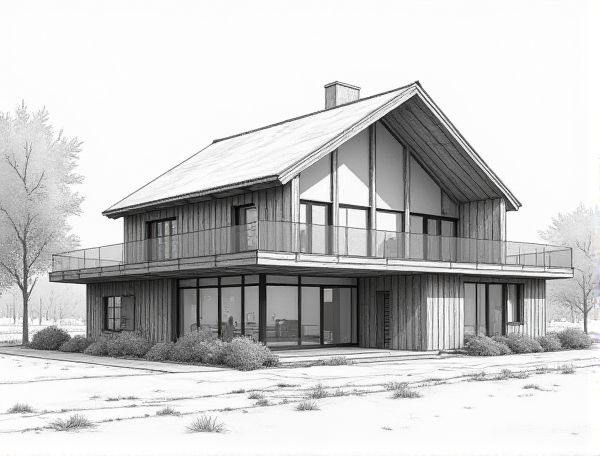
Photo illustration: Scandinavian home design with tatami room integration
Scandinavian home design emphasizes minimalism, natural light, and functional spaces, seamlessly blending with the calming aesthetics of a tatami room to create a serene and balanced atmosphere in your home. Discover how integrating these elements can transform your living space by reading more in the article.
Introduction to Scandinavian Home Design
Scandinavian home design emphasizes simplicity, functionality, and minimalism, characterized by clean lines, natural materials, and a neutral color palette. Light wood tones, white walls, and strategic use of natural light create an airy, inviting atmosphere that maximizes space and comfort. This design style integrates cozy textiles and modern furniture, promoting a harmonious, clutter-free living environment suited for both urban and rural settings.
The Essence of Tatami Rooms
Tatami rooms embody traditional Japanese aesthetics, featuring natural straw mats that regulate humidity and provide comfort, enhancing your home's tranquility and simplicity. Incorporating tatami flooring fosters a connection to nature while optimizing minimalist design and flexible living spaces.
Merging Minimalism: Scandinavian Meets Japanese
Merging minimalism in home design combines Scandinavian simplicity with Japanese wabi-sabi principles, emphasizing clean lines, natural materials, and functional spaces. This fusion highlights neutral color palettes, uncluttered rooms, and the beauty of imperfection through handcrafted decor and organic textures. Integrating these styles creates serene living environments that balance practicality with aesthetic harmony.
Benefits of Integrating Tatami Rooms
Integrating tatami rooms into your home design enhances comfort by providing natural insulation and a soothing aesthetic that promotes relaxation. These traditional Japanese-style rooms improve air quality with breathable tatami mats made from natural materials, contributing to healthier indoor living. Your home's multifunctionality increases as tatami rooms serve as versatile spaces for meditation, sleeping, or social gatherings, maximizing usability without sacrificing style.
Key Elements of Scandinavian Interiors
Natural light plays a crucial role in Scandinavian interiors, enhancing the sense of openness and tranquility. You'll find that minimalistic furniture with clean lines, combined with neutral color palettes and natural materials like wood and leather, define the aesthetic. Functional design and cozy textiles such as wool and linen further emphasize comfort and simplicity in your home.
Harmonizing Natural Materials
Incorporating natural materials such as reclaimed wood, stone, and bamboo into your home design enhances warmth and sustainability while creating a cohesive, organic aesthetic. Your space achieves a balanced harmony by blending textures and colors inspired by nature, promoting tranquility and timeless beauty.
Spatial Flow and Open Layouts
Optimizing spatial flow enhances movement efficiency by minimizing obstacles and creating intuitive pathways between functional areas. Open layouts promote natural light distribution and flexible use of space, fostering a sense of connectivity and spaciousness in modern home design. Incorporating open, unobstructed zones allows for seamless integration of living, dining, and kitchen areas, maximizing usability and aesthetic appeal.
Color Palettes: Nordic Neutrals and Japanese Aesthetics
Nordic neutrals emphasize soft, muted tones such as warm grays, sandy beiges, and off-whites, creating a calming and cohesive environment that highlights natural light and minimalist forms. Japanese aesthetics incorporate earthy hues like deep browns, moss greens, and ink blacks, paired with natural materials to evoke balance, simplicity, and a connection to nature. Combining these palettes enhances home design by merging Scandinavian tranquility with traditional wabi-sabi principles for a serene and timeless interior.
Furniture Selection and Arrangement
Choosing the right furniture involves balancing style, comfort, and functionality to enhance your living space's flow. Proper arrangement maximizes room utility, ensuring Your furniture complements natural light and traffic paths for a cohesive, inviting atmosphere.
Tips for Seamless Tatami Integration
Incorporate tatami mats by choosing sizes that align with your room's dimensions to maintain harmony and balance. Your furniture should complement traditional tatami aesthetics, favoring low-profile pieces that preserve open space and flow. Use natural materials and soft lighting to enhance the serene ambiance typical of authentic tatami rooms.
 homedesy.com
homedesy.com